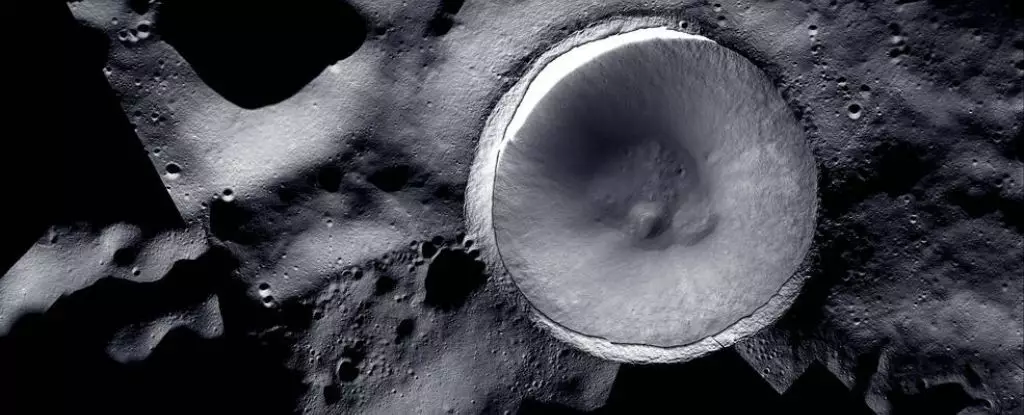In a remarkable display of ingenuity, NASA has released a flawless new image of Shackleton Crater, a lunar crater that has remained hidden from sunlight for billions of years. Located in the mountainous region of the lunar south pole, this ancient pockmark has intrigued scientists for its potential to contain water or ice in its shadowed depths. By capitalizing on the unique lighting conditions of the Moon’s polar regions, NASA’s ShadowCam has managed to shed light on this enigmatic crater, presenting a visual feast to astronomers and humanity alike.
The lunar south pole harbors what scientists call ‘cold traps’, shadowy areas where sunlight struggles to penetrate. These cold traps create an ideal environment for water or ice to exist undisturbed by the Sun’s rays. Amidst this mysterious realm, Shackleton Crater dominates the landscape, its dark middle harboring temperatures that plummet to a bone-chilling -173°C (-280°F). If remnants of ancient comet crashes indeed left traces of water vapor, they now lay frozen beneath the surface, evading detection. Intriguingly, experts in China plan to send a mini flying probe to the crater in 2026, hoping to unearth evidence of lunar water-ice. Until then, NASA’s ShadowCam continues to serve as our ‘night goggles’, delving into the perpetual darkness and unraveling the Moon’s secrets.
Launched into orbit aboard a Korean lunar satellite in August 2022, ShadowCam is a specially designed camera that surpasses all its predecessors in sensitivity to light in shadowed regions of the Moon. Its revolutionary imaging technique relies on ‘earthshine’, which is the reflection of light from our planet that illuminates the lunar surface. By harnessing earthshine and utilizing the reflection of sunlight from the Moon’s mountains and ridges, ShadowCam captures images of the Moon’s dark side with remarkable clarity. However, due to its design, the camera faces over-saturation when imaging brighter regions.
Earlier this year, scientists at NASA encountered this challenge when attempting to capture Shackleton Crater with ShadowCam. The limited sunlit areas within the crater were whited out, rendering the images incomplete. However, this setback led to a creative solution. The ShadowCam team ingeniously developed an image mosaic, combining the oversaturated images from ShadowCam with photographs captured by other lunar cameras in orbit. This innovative approach allowed for the creation of a comprehensive visual map of both the brightest and darkest parts of the Moon, unveiling details of the terrain and geological features that were previously unseen.
With each camera optimized for specific lighting conditions found near the lunar poles, the combination of images from different instruments offers unprecedented insight into the lunar landscape. This collaborative effort brings to light the true nature of the Moon’s polar regions, exposing their hidden treasures and exposing their enigmatic secrets. The enhanced visuals provided by ShadowCam’s image mosaic reveal tantalizing details, capturing the imaginations of scientists and the general public alike.
The unveiling of Shackleton Crater’s secrets is just the tip of the iceberg. As the scientific community eagerly awaits the results of the upcoming lunar probe mission planned by Chinese astronomers, the collaboration between NASA and its international partners continues to push the boundaries of lunar exploration. By harnessing the ingenious capabilities of ShadowCam and the combined power of multiple lunar cameras, researchers are steadily piecing together the long-standing mysteries of our celestial neighbor.
The flawless image of Shackleton Crater captured by NASA’s ShadowCam represents a significant milestone in lunar exploration. By overcoming the challenges of imaging the Moon’s perpetually shadowed regions, scientists have obtained unprecedented visual insights into the lunar south pole. With each new revelation, our understanding of the Moon’s geological composition and potential for housing water or ice expands. As humanity’s curiosity about the Moon grows, it is through innovative technologies like ShadowCam that we continue to unravel the secrets of our ancient, crater-ridden companion in the night sky.



Leave a Reply